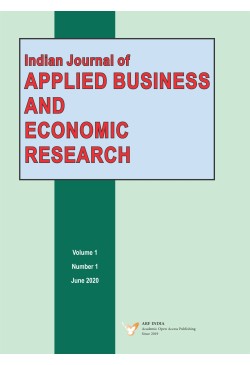
Indian Journal of Applied Business and Economic Research
Frequency :Bi-Annual
ISSN :2582-8290
Peer Reviewed Journal
Indian Journal of Applied Business and Economic Research: is open access, peer-reviewed journal whose objectives is to publish original research papers related to the Economics and Business issues. This journal is also dedicated to disseminating the published articles freely for international academicians, researchers, practitioners, regulators, and public societies.
The journal welcomes author from any institutional backgrounds and accepts rigorous empirical research paper with any methods or approach that is relevant to the Economics and Business context or content, as long as the research fits one of three salient disciplines: Economics, Business, Finance or Accounting.
INSTRUCTIONS FOR AUTHORS
Manuscript Submission: Submission of a manuscript implies: that the work described has not been published before; that it is not under consideration for publication anywhere else; that its publication has been approved by all co-authors, if any, as well as by the responsible authorities – tacitly or explicitly – at the institute where the work has been carried out. The publisher will not be held legally responsible should there be any claims for compensation.
Permissions: Authors wishing to include figures, tables, or text passages that have already been published elsewhere are required to obtain permission from the copyright owner(s) for both the print and online format and to include evidence that such permission has been granted when submitting their papers. Any material received without such evidence will be assumed to originate from the authors.
Electronic Submissions should be sent in MS Word format to the Editor-in-chief: E-mail: editorijaber@gmail.com
Editor-in-Chief: Dr. Sanjaya Acharya, Professor of Economics. Tribhuvan University, Kathmandu, Nepal, e-mail: sanjaya.acharya@gmail.com or editorijaber@gmail.com
Title Page
• The title page should include:
• The name(s) of the author(s)
• A concise and informative title
• The affiliation(s) and address(es) of the author(s)
• The e-mail address, and telephone number(s) of the corresponding author
Abstract: Please provide an abstract of 200 to 300 words. The abstract should not contain any undefined abbreviations or unspecified references.
Keywords: Please provide 4 to 6 keywords which can be used for indexing purposes and three JEL classification codes.
Text Formatting
• Manuscripts should be submitted in Word.
• Use a normal, plain font (e.g., 10-point Times Roman) for text.
• Use italics for emphasis.
• Use the automatic page numbering function to number the pages.
• Do not use field functions.
• Use tab stops or other commands for indents, not the space bar.
• Use the table function, not spreadsheets, to make tables.
• Use the equation editor or MathType for equations.
• Save your file in docx format (Word 2007 or higher) or doc format (older Word versions).
• Manuscripts with mathematical content can also be submitted in word file.
Headings: Please use the decimal system of headings with no more than three levels.
Abbreviations: Abbreviations should be defined at first mention and used consistently thereafter.
Footnotes: Footnotes can be used to give additional information, which may include the citation of a reference included in the reference list. They should not consist solely of a reference citation, and they should never include the bibliographic details of a reference. They should also not contain any figures or tables.
Footnotes to the text are numbered consecutively; those to tables should be indicated by superscript lowercase letters (or asterisks for significance values and other statistical data). Footnotes to the title or the authors of the article are not given reference symbols.
References
Reference citations in the text should be identified by numbers in square brackets. Some examples:
• Negotiation research spans many disciplines [3].
• This result was later contradicted by Becker and Seligman [5].
• This effect has been widely studied [1-3, 7].
Reference list
The list of references should only include works that are cited in the text and that have been published or accepted for publication. Personal communications and unpublished works should only be mentioned in the text. Do not use footnotes or end notes as a substitute for a reference list.
The entries in the list should be numbered consecutively.
• Journal article:
• Harris, M., Karper, E., Stacks, G., Hoffman, D., DeNiro, R., Cruz, P., et al. (2001). Writing labs and the Hollywood connection. Journal of Film Writing, 44(3), 213–245.
• Article by DOI
• Kreger, M., Brindis, C.D., Manuel, D.M., & Sassoubre, L. (2007). Lessons learned in systems change initiatives: benchmarks and indicators. American Journal of Community Psychology. https://doi.org/10.1007/ s10464-007-9108-14.
• Book
• Calfee, R. C., & Valencia, R. R. (1991). APA guide to preparing manuscripts for journal publication.Washington, DC: American Psychological Association.
• Book chapter
• O’Neil, J. M., & Egan, J. (1992). Men’s and women’s gender role journeys: Metaphor for healing, transition, and transformation. In B. R. Wainrib (Ed.), Gender issues across the life cycle (pp. 107–123). New York: Springer.
Tables
• All tables are to be numbered using Arabic numerals.
• Tables should always be cited in text in consecutive numerical order.
• For each table, please supply a table caption (title) explaining the components of the table.
• Identify any previously published material by giving the original source in the form of a reference at the end of the table caption.
• Footnotes to tables should be indicated by superscript lower-case letters (or asterisks for significance values and other statistical data) and included beneath the table body.